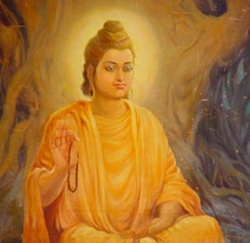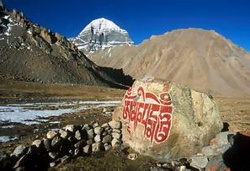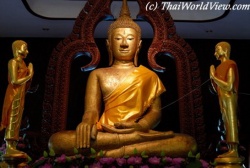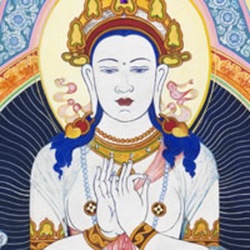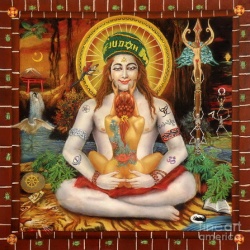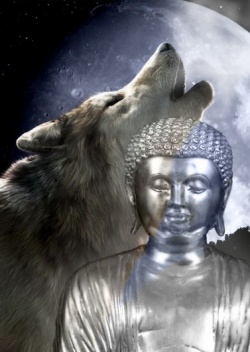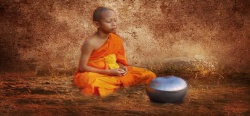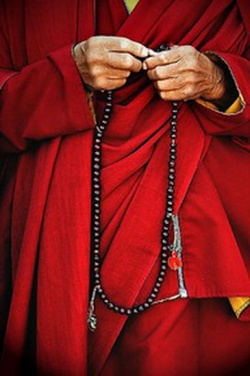Patanjali
Patañjali (Tamil: பதஞ்சலி, Sanskrit: पतञ्जलि, IPA: [pət̪əɲɟəli]) is a Sanskrit proper name. Several important Sanskrit works are ascribed to one or more authors of this name, and a great deal of scholarship has been devoted over the last century or so to the issue of disambiguation.[1]
Amongst the more important authors called Patañjali are:
The author of the Mahābhāṣya, an advanced treatise on Sanskrit grammar and linguistics framed as a commentary on Kātyāyana's vārttikas (short comments) on Pāṇini's Aṣṭādhyāyī. This Patañjali's life is the only one which can be securely dated (as one of the grammatical examples he uses makes reference to the siege of the town of Sāketā by the Greeks, an event known from other sources to have taken place around 120 BCE).
The compiler of the Yoga Sūtras, an important collection of aphorisms on Yoga practice.
One of the 18 siddhars in the Tamil siddha (Shaiva) tradition.
The author of an unspecified work of medicine (āyurveda).
In some Sanskrit grammatical works, Patañjali is called "the man from Gonarda". He is held by some to have been born at the "Gonarda" (Thiru-Gona-Malai), India. This tradition is corroborated in Tirumular's seventh-century Tamil Tirumandhiram, which describes him as hailing from Then Kailasam (Koneswaram temple, Trincomalee), and tradition has him visiting the Thillai Nataraja Temple, Chidambaram, where he wrote the Charana Shrungarahita Stotram on Nataraja.
Name
The compound name Patañjali has been explained by Sanskrit commentators in two ways. The first explanation of the word is añjalau patan iti patañjali (Patañjali is one falling into folded hands), which is a mayūravyaṁsakādi compound with śakandhvādi Sandhi. The name comes from a legend about his birth which says that Śeṣa, the divine serpent-king incarnated as a snakelet and fell into the folded hands (Anjali Mudra) of a Brahmin. The second explanation parses the word as a Bahuvrihi compound patanto namaskāryatvena janānāmañjalayo yasmin viṣaye sa (He for whom the folded hands of people are falling is Patañjali).
Life
That the Patañjalis who wrote on Yoga and on grammar were two different scholars was compellingly argued by the great scholar of Sanskrit literature, Louis Renou. Many outstanding scholars since then have reexamined the question and come to the same conclusion.[9]
The tradition that one Patañjali wrote treatises on grammar, medicine and yoga is memorialized in a verse by Bhoja at the start of his commentary on the Yogasutras. This tradition is discussed by Meulenbeld who traces this "relatively late" idea back to Bhoja (11th century CE), who was perhaps influenced by a verse by Bhartṛhari (ca. 5th century CE) that speaks of an expert in yoga, medicine and grammar who, however, is not named.
Grammar tradition
In the grammatical tradition, Patañjali is believed - for the reason given above - to have lived in the second century BCE Some say that he lectured on Paninian grammar at a place called Nāgakūpa, which is identified with modern day Nagakuan (Hindi: नागकुआँ).[7] He lectured for 85 days, which resulted in the 85 Āhnikas or "daily lessons" of the Mahābhāṣya. Many writers in the grammar tradition, including Bhaṭṭojī Dīkṣita, Hari Dīkṣita, Nāgeśa Bhaṭṭa, and Kaunda Bhaṭṭa, held Patañjali to be an incarnation of the mythical serpent Śeṣa.
Yoga tradition
In the Yoga tradition, Patañjali is a revered name and has been deified by many groups, especially in the Shaivite bhakti tradition. It is claimed by some that Patañjali is an incarnation of the mythical serpent Ananta. This Patañjali's oevre comprises the sutras about Yoga (Yogasūtra) and the commentary integral to the sutras, called the Bhāṣya. In the past, the sutras and the Bhaṣya have been considered by some to have had different authors, the commentary being ascribed to "an editor" (Skt. "vyāsa"). However, a recent comprehensive reexamination of all the evidence has confirmed the view of many older Sanskrit authors in the period before 1000 CE that one and the same person composed the sutras and the Bhāṣya commentary.[10] The same study also confirms the date of composition of this work as falling in approximately 400 BCE.
Regarding his early years, a Tamil Shaiva Siddhanta tradition from around 10th century AD holds that Patañjali learned Yoga along with seven other disciples from the great Yogic Guru Nandhi Deva, as stated in Tirumular's Tirumandiram (Tantra 1).
Nandhi arulPetra Nadharai Naadinom
Nandhigal Nalvar Siva Yoga MaaMuni
Mandru thozhuda Patañjali Vyakramar
Endrivar Ennodu (Thirumoolar) Enmarumaame
Translation
We sought the feet of the Lord who graced Nandikesvara
The Four Nandhis,
Sivayoga Muni, Patañjali, Vyaghrapada and I (Thirumoolar)
We were these eight.
The ancient Kali Kautuvam also describes how Patañjali and Vyagrapada gathered along with the gods in Thillai near Chidambaram to watch Shiva and Kali dance and perform the 108 mystic Karanas, which formed the foundation for the system of Natya Yoga. He has also written Charana Shrungarahita Stotram on Nataraja.
This Tamil tradition also gives his birthplace in South Kailash - Koneswaram temple, Trincomalee. Some other traditions feel that his being born in Bharatavarsha - the part of the ancient world corresponding to South Asia - is beneath his godlike status, and that he must have been born in the Jambudvipa, the mythical center of the universe.
Patañjali as Siddha is also mentioned by the goldsmith-sage Bogar:
It was why my Grandfather who said, "Climb and see."
But it was Kalangi Nathar who gave me birth.
Patañjali,Viyagiramar,and Sivayogi Muni all so rightly said,
"Look! This is the path!" - Bhogar 7000 (translation by Layne Little)
This tradition also holds that Patañjali was a master of dance.
Other legends
In one popular legend, Patañjali was born to Atri and his wife Anasuya (this would make him go back to the time of the creation by Brahma). According to this tradition, Anasuya had to go through a stern test of her chastity when the Trimurti themselves came as Bhikshuks and asked her for Bhiksha. She passed their test by accepting them as her children and fed them. She got the boon where all the three Murtis will be born to them. They were Soma Skandan or Patañjali, Dattatreya, and Durvasa.
Samadhi
The Samadhi of Patanjali's Maharishi is believed to be in Tirupattur Brahmapureeswarar Temple (30 km from Trichy), where Lord Brahma installed 12 Shiva Lingams and worshipped Lord Shiva to get back his Tejas.[citation needed]
Shankaracharya's guru had told Shankaracharya that Patanjali's was reincarnated as Govinda Bhagavatpada and was meditating in a cave somewhere in the state of samadhi.
Ascribed works
Whether the two works, the Yoga Sutras and the Mahābhāṣya, are by the same author has been the subject of considerable debate. The authorship of the two is first attributed to the same person in Bhojadeva's Rajamartanda, a relatively late (10th century) commentary on the Yoga Sutras, as well as several subsequent texts. As for the texts themselves, the Yoga Sutra iii.44 cites a sutra as that from Patanjali's by name, but this line itself is not from the Mahābhāṣya. This 10th-century legend of single-authorship is doubtful. The literary styles and contents of the Yogasūtras and the Mahābhāṣya are entirely different, and the only work on medicine attributed to Patañjali is lost. Sources of doubt include the lack of cross-references between the texts, and no mutual awareness of each other, unlike other cases of multiple works by (later) Sanskrit authors. Also, some elements in the Yoga Sutras may date from as late as the 4th century AD, but such changes may be due to divergent authorship, or due to later additions which are not atypical in the oral tradition. Most scholars refer to both works as "by Patanjali's", without meaning that they are by the same author.
In addition to the Mahābhāṣya and Yoga Sūtras, the 11th-century commentary on Charaka by the Bengali scholar Cakrapāṇidatta, and the 16th-century text Patanjalicarita ascribes to Patañjali a medical text called the Carakapratisaṃskṛtaḥ (now lost) which is apparently a revision (pratisaṃskṛtaḥ) of the medical treatise by Caraka. While there is a short treatise on yoga in the medical work called the Carakasaṃhitā (by Caraka), towards the end of the chapter called śārīrasthāna, it is notable for not bearing much resemblance to the Yoga Sūtras, and in fact presenting a form of eightfold yoga that is completely different from that laid out by Patañjali in the Yoga Sūtras and the commentary Yogasūtrabhāṣya.
The tradition that holds that all three works are by the same author is summed up in this verse from the beginning of Bhoja's Rājamārttanda commentary on the Yoga Sūtras:
yogena cittasya, padena vācāṃ, malaṃ śarīrasya ca vaidyakena ।
yo'pākarot taṃ pravaraṃ munīnāṃ patañjaliṃ prāñjalir ānato'smi ॥
पतञ्जलिप्रार्थनं॥ योगेन चित्तस्य पदेन वाचां मलं शरीरस्य च वैदिकेन । योपाकरोत्तं प्रवरं मुनीनां पतञ्जलिं प्राञ्जलिरानतोस्मि॥
English translation: I bow with my hands together to the eminent sage Patañjali, who removed the impurities of the mind through yoga, of speech through grammar, and of the body through medicine.
Yoga Sūtra
The Yoga tradition is much older, there are references in the Mahābhārata, and the Gitā identifies three kinds of yoga. The Yoga Sūtras codifies the royal or best (rāja) yoga practices, presenting these as an eight-limbed system (ashtānga). The philosophic tradition is related to the Sankhya school. The focus is on the mind; the second sutra defines Yoga - it is the cessation of all mental fluctuations, all wandering thoughts cease and the mind is focused on a single thought
In contrast to the focus on the mind in the Yoga sutras, later traditions of Yoga such as the Hatha yoga focus on more complex asanas or body postures.
Relevance of his contribution to the science of yoga
Patañjali defended in his yoga-treatise several ideas that are not mainstream of either Sankhya or Yoga. He, according to the Iyengar adept, biographer and scholar Kofi Busia, acknowledges the ego not as a separate entity. The subtle body linga sarira he would not regard as permanent and he would deny it a direct control over external matters. This is not in accord with classical Sankhya and Yoga.
Although much of the aphorisms in the Yoga Sutra possibly pre-dates Patanjali's, it is clear that much is original and it is more than a mere compilation. The clarity and unity he brought to divergent views prevalent till then has inspired a long line of teachers and practitioners up to the present day in which B.K.S. Iyengar is a known defender. With some translators he seems to be a dry and technical propounder of the philosophy, but with others he is an empathic and humorous witty friend and spiritual guide.
Mahābhāṣya
The Mahābhāṣya ("great commentary") of Patañjali on the Aṣṭādhyāyī of Pāṇini is a major early exposition on Pāṇini, along with the somewhat earlier Varttika by Katyayana. Here he raises the issue of whether meaning ascribes to a specific instance or to a category:
kim punar AkritiH padArthaH, Ahosvid dravyam.
Now what is 'meaning' (artha) [of a word)? Is it a particular instance (dravya) or a general shape (Akriti)
This discussion arises in Patanjali's in connection with a sutra (Pāṇini 1.2.58) that states that a plural form may be used in the sense of the singular when designating a species (jAti).
Another aspect dealt with by Patanjali's relates to how words and meanings are associated - Patanjali's claims shabdapramâNaH - that the evidentiary value of words is inherent in them, and not derived externally - the word-meaning association is natural. The argument he gives is that people do not make an effort to manufacture words. When we need a pot, we ask the potter to make a pot for us. The same is not true of words - we do not usually approach grammarians and ask them to manufacture words for our use. This is similar to the argument in the early part of Plato's Cratylus, where morphemes are described as natural, e.g. the sound 'l' is associated with softness.
These issues in the word-meaning relation (symbol) would elaborated in the Sanskrit linguistic tradition, in debates between the Mimamsa, Nyaya and Buddhist schools over the next fifteen centuries.
Sphota
Patanjali's also defines an early notion of sphota, which would be elaborated considerably by later Sanskrit linguists like Bhartrihari. In Patanjali's, a sphoTa (from sphuT, burst) is the invariant quality of speech. The noisy element (dhvani, audible part) can be long or short, but the sphoTa remains unaffected by individual speaker differences. Thus, a single letter or 'sound' (varNa) such as k, p or a is an abstraction, distinct from variants produced in actual enunciation. This concept has been linked to the modern notion of phoneme, the minimum distinction that defines semantically distinct sounds. Thus a phoneme is an abstraction for a range of sounds. However, in later writings, especially in Bhartrihari (6th century CE), the notion of sphoTa changes to become more of a mental state, preceding the actual utterance, akin to the lemma.
Patañjali's writings alsΆΈo elaborate some principles of morphology (prakriyā). In the context of elaborating on Pāṇini's aphorisms, he also discusses Kātyāyana's commentary, which are also aphoristic and sūtra-like; in the later tradition, these were transmitted as embedded in Patañjali's discussion. In general, he defends many positions of Pāṇini which were interpreted somewhat differently in Katyayana.
Metaphysics as grammatical motivation
Unlike Pāṇini's objectives in the Ashtyadhyayi which is to distinguish correct forms and meanings from incorrect ones (shabdaunushasana), Patanjali's objectives are more metaphysical. These include the correct recitations of the scriptures (Agama), maintaining the purity of texts (raksha), clarifying ambiguity (asamdeha), and also the pedagogic goal of providing an easier learning mechanism (laghu). This stronger metaphysical bent has also been indicated by some as one of the unifying themes between the Yoga Sutras and the Mahābhāṣya, although a close examination of actual Sanskrit usage by Woods showed no similarities in language or terminology.
The text of the Mahābhāṣya was first critically edited by the 19th-century orientalist Franz Kielhorn, who also developed philological criteria for distinguishing Kātyāyana's "voice" from Patañjali's. Subsequently a number of other editions have come out, the 1968 text and translation by S.D. Joshi and J.H.F. Roodbergen often being considered definitive. Regrettably, the latter work is incomplete.
Patanjali also writes with a light touch. For example, his comment on the conflicts between the orthodox Brahminic (Astika) groups, versus the heterodox, nAstika groups (Buddhism, Jainism, and atheists) seems relevant for religious conflict even today: the hostility between these groups was like that between a mongoose and a snake.[18] He also sheds light on contemporary events, commenting on the recent Greek incursion, and also on several tribes that lived in the Northwest regions of the subcontinent.
